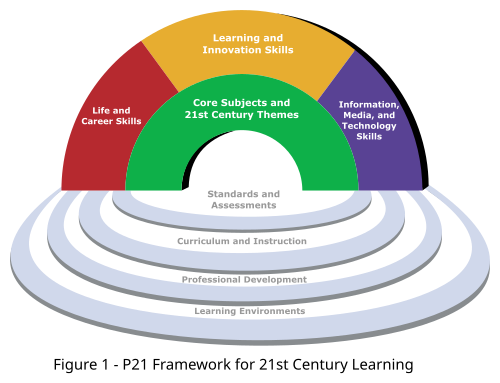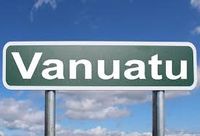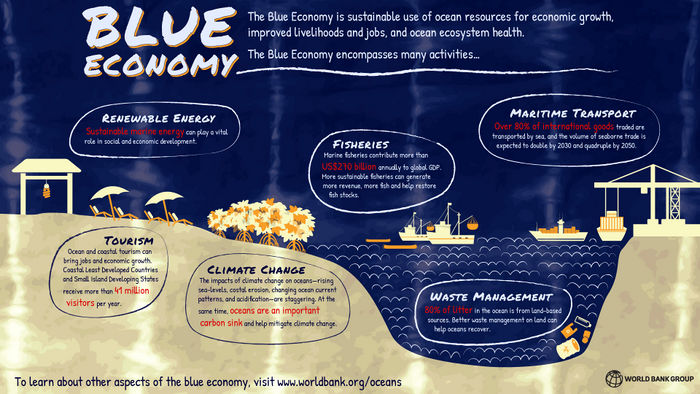QA4ODFL2/Course/Open schooling curriculum
Contents
[hide]Empowering curriculum
With the world becoming more and more of a global village, education systems should aim to equip learners with 21st Century skills that enable them to be versatile and adaptable to any economy. At the same time, learners should master innovative skills to enable them to solve real life problems. Figure 1 shows a broad curriculum framework course developers and teachers can draw on to develop a rich curriculum for open schooling.
Figure 1 Source: Fadel & Velaga, (2019) CC BY-SA 4.0
The flexibility of provision in open schools accommodates learners of different ages, interests and needs. Often, there are learners who enrol in open schooling just to acquire specific skills and competencies that make them more marketable or functional in the job market. In addition to purely secondary school subjects similar to those offered in conventional schools, these learners need vocational-type courses to master the skills they need. Ideally, the vocational/technical courses are short and either involve work attachments or target people who are already in employment. These vocational courses tend to be popular with youths who are self-employed, like plumbers, electricians, painters, etc. For example, the Namibian College of Open Learning offers the following courses up to Level 3 on the Namibia Qualifications Framework: Automotive Mechanics, Plumbing and Pipefitting, Welding and Metal Fabrication and Office Administration, (Nitschke, 2013) . A good open schooling curriculum should achieve a balance between a purely academic track and a vocational and skills development track. In many developing economies, such medium-level skills are essential in making young people more employable thereby reducing the problem of youth unemployment. That is what promotes sustainable livelihoods and improves living conditions of communities.
Enriching open schooling curriculum through OER
You don’t have to start from scratch. You can make your life easier by finding and using already existing courses that are openly licensed, and adapting them for your context. As teachers and education officers, you can also publish your courses as OER to enable other people to access and use them. In addition to looking for existing courses, you can search for learning materials to support courses you already have. Your ability to search for and adapt OER will be very useful to you. Let’s build a community of sharing in open schooling. To learn about how to search for and adapt OER, read the short tutorials on the following links during your own time:
Finding OER: (https://www.oerafrica.org/communication/find-open-content/index.html#/ )
Adapting OER: ([ https://www.oerafrica.org/communication/adapt-new-content/#/ https://www.oerafrica.org/communication/adapt-new-content/#/ ])
Although open schooling offers vocational and skills training, the level of skills is generally not the high-level specialised type, unless the offerings are developed from certificate to Diploma and degree level. Most Certificate qualifications offer low to middle-level skills that nevertheless enable holders to offer basic services in the economy, as highlighted above. This makes articulation with higher qualifications offered by other institutions like technical colleges and universities essential. So, in designing the open schooling curriculum, you should consider advancement pathways that your learners will pursue. The nature of such articulation can either be vertical or horizontal. The guiding principle is that offerings should not result in learners running into a dead end.
Articulation of open schooling qualifications means locating offerings appropriately within the National Qualifications Framework. Even if the offerings are short courses, they should be designed in such a way that they can contribute towards credit accumulation. In many countries, education institutions now design regular micro-credential courses as a way of supporting skills/competencies development. Accumulation of such micro-credentials leads to a formal certificate being issued by a registered institution. Many people prefer to take these micro-credential courses because they are short and offer knowledge and skills that are of immediate use at the workplace.
Keeping the curriculum relevant
In recent times, the world has witnessed rapid changes in the way business is conducted and how people interact and navigate their day to day activities. At the same time, the changes have brought about numerous challenges that call for new knowledge, skills and competencies that were not as compelling in the past. For educational institutions to remain relevant, they need to take into account these challenges and adapt the curriculum appropriately. Learners should be equipped with entrepreneurial skills that facilitate job creation and easy transfer of skills. Thus, open schooling curriculum should harness the affordances of new information and communication technology to equip learners with the relevant skills called for in the workplace and in life in general. The emphasis should be on improving learners’ basic skills in using technology as a powerful tool for solving problems. Learners should be empowered to search for information and build solutions to problems using available technology. Thus, embracing technology-enabled learning (TEL) has immense potential to encourage learners to find information, to develop financial and scientific literacy, and to be generally versatile in life. It also encourages learners to develop critical thinking and problem-solving skills, to be more creative, to communicate more effectively and faster, and to collaborate in learning and in navigating life challenges generally. For this to happen, policy makers and teachers need to be deliberate about the kind of technologies they integrate in the curriculum and how they operationalise them on a day-to day basis.
Education and climate change
Besides the rapid economic changes the world is experiencing, there are many challenges that are being brought about by climatic changes. These challenges are exacerbated by pandemics that pose threats to human life as well as to education systems. Unusual heat waves, devastating floods, severe droughts, volcanic ash and tsunamis have resulted in adverse conditions that have threatened the welfare of human beings in general and tested the resilience of education systems. For example, when COVID-19 hit all forms of business and day to day human activities were negatively affected by restrictions to movement and gatherings, which resulted in the closure of education institutions. Innovative ways of sustaining education were called for and this demonstrated the importance of not only designing for different type of learners, but also for the different conditions under which learning takes place.
Pacific countries as blue economies
Curriculum should be relevant to learners’ living experiences to make learning authentic. There is no point in learning what is not relevant for life. So, both the content and the methods of teaching and learning should prepare learners to use the knowledge and skills learnt to solve real life problems. Threats to human life that are caused by increasing climatic changes and industrialisation need to be addressed by education systems. For example, societies in Pacific countries rely heavily on oceans for their livelihoods and yet these marine environments are some of the poorly managed ecosystems in the world. Rising marine temperatures, dumping of industrial waste, especially plastic material and over exploitation of marine resources are some of the factors that pose threats to these blue economies. According to the World Bank, blue economy refers to the sustainable exploitation of ocean resources for economic growth, improved livelihoods, and jobs while preserving the health of ocean ecosystem, (World Bank, 2017) . As the Bank argues, an important challenge of the blue economy is to understand and better manage the many aspects of oceanic sustainability, ranging from sustainable fisheries to ecosystem health to pollution, (Ibid). The need for collaboration across countries and across public-private sectors in managing such ecosystems cannot be overemphasized. “This realization underscores the challenge facing the Small Island Developing States (SIDS) and Least Developed Countries (LDCs) as they turn to better managing their blue economies,” (World Bank, 2017:vi) .
Embracing technology to overcome learning challenges
The advent of technology has ushered in new and better ways of teaching and learning. Rapid expansion in blended learning, advances in technology and digital teaching aids, and the increased availability and uptake of online distance learning are driving a need for new approaches to assessment for eLearning. Many open schooling systems have since embraced technology-enabled learning (TEL) to ensure inclusive and equitable quality education and promote lifelong learning opportunities for all. TEL signifies a shift from the traditional paper-based teaching approach to an e-tutor facilitated, self-directed, blended/online learning approach. This approach to teaching and learning provides the flexibility that accommodates non-traditional learners and therefore promotes access. Appropriate use of TEL is driven by the teacher who seeks to draw on technology to advance a particular teaching and learning strategy. The underlying pedagogy is important; otherwise blind use of technology might not necessarily yield desired results. It is not the technology that matters, but the pedagogy that guides which technology to use and how to use it. However, if appropriately used, technology:
- Enhances convenience for students and staff;
- Promotes development of digital Literacy amongst students and staff;
- Empowers students and staff with enhanced learning environments and activities;
- Enhances engagement with content thereby supporting the development of lifelong learning skills;
- Facilitates delivering high quality, reliable, efficient, integrated, intuitive, user experience focussed solutions and support.
Table 1: Common challenges faced in using different types of technology in teaching and learning
| Technology | Challenges | Alleviating |
|---|---|---|
| Desktop | Fixed in one place and therefore use limited to particular places.
Requires reliable source of electricity |
Provide desktops at regional study centres easily accessible by learners.
Go into partnerships with other organisations with relevant technology which learners can access. |
| Laptop | Unlike desktop, can run on battery but for limited period of time, so will still need charging.
Too expensive for many learners Need backup support Also needs backup support Vulnerable to thefts |
Invest in solar systems at regional centres
Build cost into student fees Look for donors Establish technical support service for learners – can outsource the service where necessary. |
| Tablets | Cost too high for many learners
Although they run on batteries, still need charging. Require technical backup |
Build cost into student fees
Find donors |
| Smart phones | Screen too small for reading | Use for limited content – mainly for short documents |
| Smart board | Fixed in one place
Require delicate technical maintenance and storage. Generally, too expensive for many institutions. |
Use for lessons beamed on television. |
Updating courses
To keep the content of your courses relevant, there is need for constant reviewing and updating. This is particularly important given that technologies change rapidly, so do the kind of challenges that learners face in the world of work. Regular scanning of the environment is necessary to keep abreast with these changes. Good open schools conduct market surveys on a regular basis to find out where the need lies and decide how to revise existing offerings or even develop new ones.


